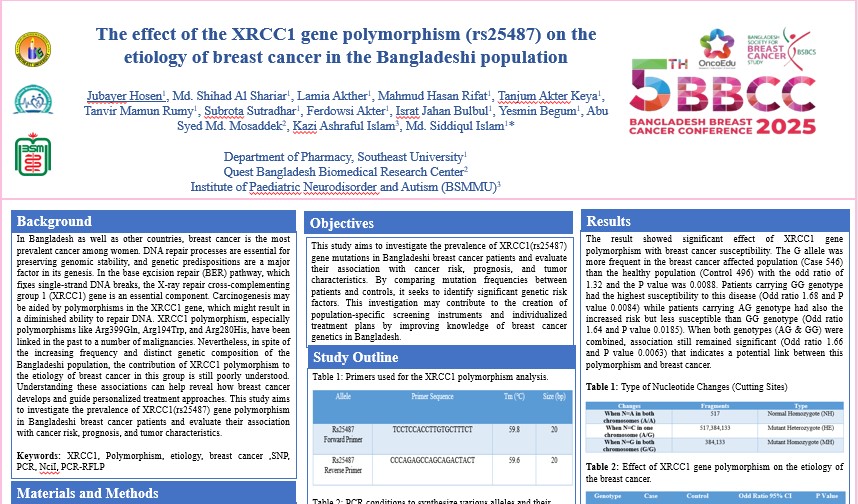The effect of the XRCC1 gene polymorphism (rs25487) on the etiology of breast cancer in the Bangladeshi population.
Authors: Jubayer Hosen1, Md. Shihad Al Shariar1, Lamia Akther1, Mahmud Hasan Rifat1, Tanjum Akter Keya1, Tanvir Mamun Rumy1, Subrota Sutradhar1, Ferdowsi Akter1, Israt Jahan Bulbul1, Yesmin Begum1, Abu Syed Md. Mosaddek2, Kazi Ashraful Islam3, Md. Siddiqul Islam1*
Institution: Department of Pharmacy, Southeast University1, Quest Bangladesh Biomedical Research Center2, Institute of Paediatric Neurodisorder and Autism (BSMMU) 3
Introduction
In Bangladesh as well as other countries, breast cancer is the most prevalent cancer among women. DNA repair processes are essential for preserving genomic stability, and genetic predispositions are a major factor in its genesis. In the base excision repair (BER) pathway, which fixes single-strand DNA breaks, the X-ray repair cross-complementing group 1 (XRCC1) gene is an essential component. Carcinogenesis may be aided by polymorphisms in the XRCC1 gene, which might result in a diminished ability to repair DNA. XRCC1 polymorphism, especially polymorphisms like Arg399Gln, Arg194Trp, and Arg280His, have been linked in the past to a number of malignancies. Nevertheless, in spite of the increasing frequency and distinct genetic composition of the Bangladeshi population, the contribution of XRCC1 polymorphism to the etiology of breast cancer in this group is still poorly understood. Understanding these associations can help reveal how breast cancer develops and guide personalized treatment approaches. This study aims to investigate the prevalence of XRCC1(rs25487) gene polymorphism in Bangladeshi breast cancer patients and evaluate their association with cancer risk, prognosis, and tumor characteristics.
Methods
In the beginning of this project, Samples was collected from different organizations treating breast cancer. Then genomic DNA was isolated from blood samples of 400 breast cancer patients and 400 healthy controls by Isolation kit. By designing and collecting appropiate primers, Polymerase chain reaction (PCR) method used to amplify the targeted region of the XRCC1 gene. The PCR products were subjected to restriction enzyme digestion using NciI restriction enzyme, followed by Polymerase Chain Reaction-Restriction Fragment Length Polymorphism (PCR-RFLP) analysis to detect single nucleotide polymorphisms (SNPs). The digested fragments were analyzed on an agarose gel electrophoresis to identify genotypic variations. This method allowed for the efficient identification of XRCC1 polymorphisms associated with breast cancer in the studied population.
Results
The result showed significant effect of XRCC1 gene polymorphism with breast cancer susceptibility. The G allele was more frequent in the breast cancer affected population (Case 546) than the healthy population (Control 496) with the odd ratio of 1.32 and the P value was 0.0088. Patients carrying GG genotype had the highest susceptibility to this disease (Odd ratio 1.68 and P value 0.0084) while patients carrying AG genotype had also the increased risk but less susceptible than GG genotype (Odd ratio 1.64 and P value 0.0185). When both genotypes (AG & GG) were combined, association still remained significant (Odd ratio 1.66 and P value 0.0063) that indicates a potential link between this polymorphism and breast cancer.
Conclusion
The results indicate that the XRCC1(rs25487) polymorphism, specifically the G allele, may contribute to breast cancer susceptibility. Individuals with the AG and GG genotypes are at a much greater risk than those with the AA genotype. These findings emphasize the potential of XRCC1 as a genetic marker for assessing breast cancer risk.
